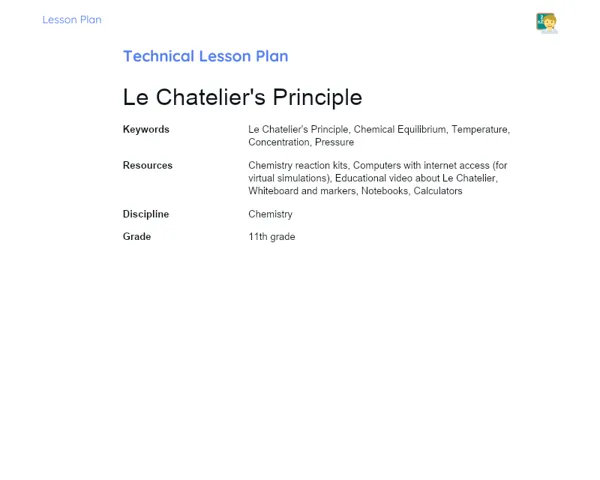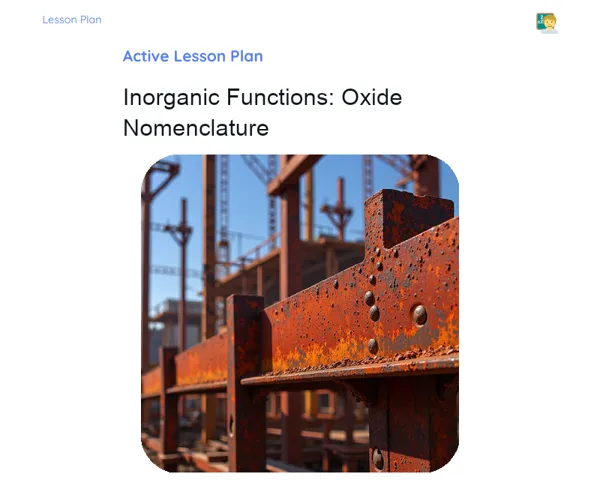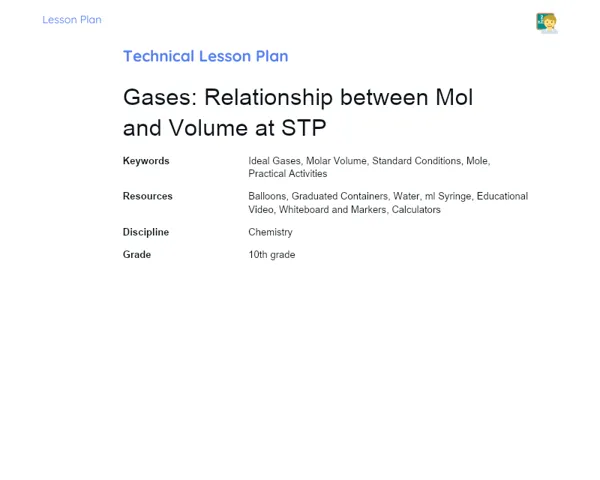Lesson Plan | Lesson Plan Iteratif Teachy | Subject: Physical, Chemical, and Organoleptic Properties
| Keywords | Properties of Matter, Physical Properties, Chemical Properties, Organoleptic Properties, Digital Methodology, Active Methodology, Interactive Lesson, Technology in Education, Social Media, Gamification, Digital Escape Room, Quiz Show, Collaborative Learning, 360° Feedback, Contextualized Learning, Student Engagement |
| Resources | Smartphones with internet access, Video editing apps (e.g., TikTok, Instagram Reels, YouTube Shorts), Interactive quiz platforms (e.g., Kahoot!, Quizizz), QR codes for digital riddles, Links for online riddles, Computers or tablets, Projector for displaying videos and quizzes, Small rewards for motivation (e.g., symbolical certificates) |
| Codes | - |
| Grade | 10th grade |
| Discipline | Chemistry |
Goal
Duration: 10 - 15 minutes
This stage aims to equip students with a comprehensive understanding of the properties of matter. By outlining clear objectives, both primary and secondary, the teacher steers the lesson's direction and ensures that activities align with anticipated outcomes, promoting active and contextualized learning.
Goal Utama:
1. Identify the specific properties of matter and distinguish them from general properties.
2. Categorize the properties of matter into physical, chemical, or organoleptic.
Goal Sekunder:
- Encourage students to apply what they've learned in real-world situations.
- Foster teamwork among students through group activities.
Introduction
Duration: (15 - 20 minutes)
This stage's purpose is to engage students from the outset, harnessing technology to aid the learning journey. By discovering and sharing intriguing facts, students connect practically and dynamically with the topic, paving the way for productive discussions and deeper exploration of concepts.
Warming Up
Warm-Up: Initiate the lesson by explaining to students that understanding the physical, chemical, and organoleptic properties of matter is essential for grasping how materials interact and behave. Ask them to find an interesting fact about one of these properties using their smartphones. This could include fun trivia about how particular materials react in different scenarios or how sensory attributes are used in the food industry. 🔍📱
Initial Thoughts
1. What are the key differences between physical and chemical properties?
2. In what way do organoleptic properties affect our food perception?
3. Can you share examples of physical properties you notice in your daily life?
4. What are some chemical reactions you have observed?
5. How does modern technology assist us in identifying and differentiating these properties?
Development
Duration: 70 - 80 minutes
The aim of this stage is to create an active and contextual learning experience, allowing students to apply existing knowledge through engaging and collaborative activities. By integrating modern technologies and enjoyable formats, students take an active role in their learning process, aiding retention and understanding of the concepts explored.
Activity Suggestions
Activity Recommendations
Activity 1 - Science Influencers
> Duration: 60 - 70 minutes
- Goal: Investigate and explain the specific properties of matter in a creative and relevant context using popular digital platforms among youth.
- Deskripsi Activity: Students will create content styled like digital influencers to explain the properties of matter (physical, chemical, and organoleptic). Each group selects one property and produces a short video, mimicking a social media post on platforms like TikTok, Instagram Reels, or YouTube Shorts. They should be creative and use everyday examples to express their explanations in an engaging manner.
- Instructions:
-
Divide the class into groups of up to 5 students.
-
Each group selects a property of matter: physical, chemical, or organoleptic.
-
Groups will brainstorm and plan how to explain their property in a short video (1-2 minutes).
-
Students may use their smartphones and video editing apps to create content.
-
Encourage the use of relevant and relatable examples, as well as clear and energetic language.
-
In the end, each group presents their video to the class and discusses the choices they made in their content.
Activity 2 - Digital Escape Room: Properties of Matter
> Duration: 60 - 70 minutes
- Goal: Encourage a profound understanding of the properties of matter through collaborative problem-solving in an fun and interactive setup.
- Deskripsi Activity: Turn the classroom into a digital escape room where students are tasked with solving riddles related to physical, chemical, and organoleptic properties to 'escape'. Each group will receive clues and challenges through links and QR codes accessible via their smartphones.
- Instructions:
-
Organize the class into groups of up to 5 students.
-
Provide a set of digital riddles featuring QR codes and links to solve. Each riddle pertains to a property of matter.
-
Students must scan the QR codes and follow links for supplementary information to crack the riddles.
-
Riddles may consist of multiple-choice questions, video questions, puzzles, and other interactive tasks.
-
Groups should collaborate to solve all riddles within the given timeframe.
-
Eventually, review the answers and discuss the concepts presented in each riddle.
Activity 3 - Gamification: Interactive Quiz Show
> Duration: 60 - 70 minutes
- Goal: Reinforce understanding of the properties of matter in an engaging and enjoyable manner, promoting active involvement and friendly competition among students.
- Deskripsi Activity: Students will engage in an interactive quiz show using platforms like Kahoot! or Quizizz. The quiz will feature questions related to physical, chemical, and organoleptic properties of matter. Participants will earn points for correct and rapid answers, fostering healthy competition and active learning.
- Instructions:
-
Split the class into groups of up to 5 students.
-
Create or select a quiz with questions about the properties of matter using a digital platform (Kahoot!, Quizizz, etc.).
-
Students should utilize their smartphones or computers to participate in real-time.
-
Each question will display on the main screen, and students must respond using their devices.
-
At the conclusion of the quiz, review the questions and answers, emphasizing the key concepts covered.
-
Reward the winning team with a small incentive (e.g., a participation bonus, symbolic certificate, etc.).
Feedback
Duration: (15 - 20 minutes)
This stage's purpose is to solidify learning through reflection and sharing, promoting a richer understanding of the content discussed. Group discussion fosters a diversity of perspectives and collaboration, while 360° feedback enables students to appreciate their strengths and recognize areas for growth, promoting the ongoing enhancement of social and cognitive skills.
Group Discussion
🎤 Group Discussion: Facilitate a discussion where groups share insights from the activities undertaken. Use the following script to kick off the discussion:
- Introduction: Appreciate everyone for their engagement in the activities and underline the significance of sharing knowledge and experiences.
- Group Presentations: Request each group to present their findings within 3 minutes.
- Follow-Up Questions: Inquire about any challenges faced and strategies employed in overcoming them.
- Open Discussion: Allow other students to pose questions and provide comments on their peers' presentations.
Reflections
1. Which property of matter intrigued you the most, and why? 2. What were the main hurdles encountered during the activities, and how were they dealt with? 3. How did the use of digital technologies aid or obstruct the learning experience regarding the properties of matter?
Feedback 360º
💬 360° Feedback: At the conclusion of the presentations, guide students to conduct a 360° feedback session. Each member should receive constructive criticism from their group counterparts. Facilitate to ensure the feedback is specific, respectful, and focused on positive aspects and areas for improvement. Tips for effective feedback:
- Specific: Address particular actions and behaviors, steering clear of generalizations.
- Constructive: Offer improvement suggestions without being judgmental.
- Respectful: Maintain a friendly and courteous tone, acknowledging contributions made by the peer.
Conclusion
Duration: (10 - 15 minutes)
📚 Conclusion Objective: This stage seeks to reinforce the lesson's key takeaways, making the main concepts memorable and connecting them to real-life scenarios. By summarizing, contextualizing, and discussing practical implications, students can recognize the relevance of the topic in their everyday experiences, encouraging meaningful and enduring learning.
Summary
🎉 Fantastic Summary! 🎉: In this lesson, we explored the fascinating world of the properties of matter! We delved into how physical properties can be perceived without changing the identity of substances, how chemical properties involve transformations and reactions, and how organoleptic properties relate to our senses – taste, aroma, texture, and appearance. 🚀 During our digital adventures, we produced videos, tackled challenges, and engaged in interactive quizzes to solidify these concepts dynamically and entertainingly!
World
🌐 Relevance to Today's World: Studying the properties of matter is more than just an academic activity; it is intertwined with our contemporary environment. With the growing significance of social media, the ability to present information engagingly is crucial. Just as digital influencers must comprehend their audience and how their messages explore different senses, understanding matter's properties equips us to perceive how the materials around us interplay and are perceived.
Applications
🧪 Practical Applications: Grasping the properties of matter is vital for numerous aspects of daily life, from the food industry, where organoleptic properties are pivotal, to tech sectors, where physical and chemical properties shape the development of new materials and products. This awareness heightens our understanding of the world and the ongoing interactions between various substances.



